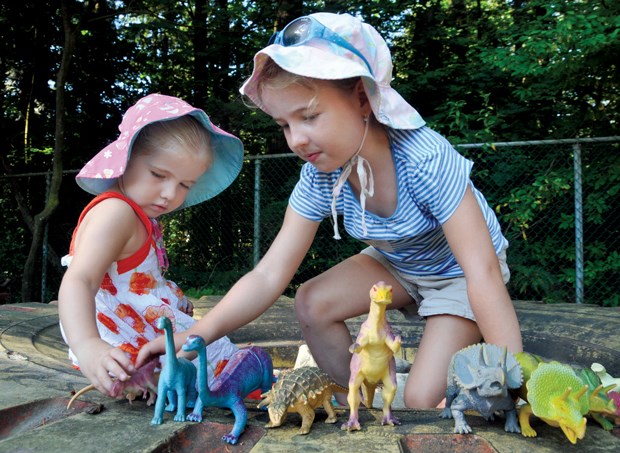Question:
When I was a child I spent all my free time outdoors. I'd jump on my bike to find my friends and we'd climb trees, have acorn cup tea parties on front lawns and arrive back home dusty, hungry and excited about our plans for the next day. I'm feeling nostalgic for my childhood of unstructured play and regretful that my children (three, six and 12 years old) are not having a similar experience. I want my children to be able to play outside, but people around me say it's not safe. Can you help me sort through this?
Answer:
Despite our beautiful natural surroundings on the North Shore, many children in our community are not experiencing as much active outdoor play time as their parents did as children. Your children will benefit from a connection with the natural world and one of the best ways to cultivate this is through unstructured outdoor play. Once outside, children will naturally ramble through tall grass, tromp in mud puddles, turn shells and tunnel under leaves.
What are we losing by not getting our kids outside? On the 2014 Active Healthy Kids Report Card, Canada was given the sobering statistic of D-on the physical health of our children, despite being relatively wellrated on organized sport activities.
Researchers from the University of Regina have found that children who spent most of their afterschool time outside were three times more likely to meet guidelines for daily physical activity and were in better shape than those who spent all of their after-school time indoors. According to the 2014 study's lead author, Dr. Lee Schaefer, "If we can get students outside more often, they are going to be more active, which is going to benefit them in the long term."
When children play outside they burn energy and develop physical literacy as they use their large muscles to run, push, jump and skip. They charge their imaginations as games are invented from what is naturally around them. Additionally, children begin to evaluate risk, problem solve and make decisions as they discover things such as the silliest way to cross a creek, the best place to dig a sand moat on the beach and the highest point from which they can comfortably land.
With your encouragement, guidance and supervision, young children will benefit by learning to observe and interact in the world around them. Right from infancy you can explore local parks, trails and even backyards, where together you can gather elements for fort building, gather piles of leaves or plant a garden to discover planning, planting and harvesting. Look for opportunities in your wandering to share knowledge and encourage learning such as noticing the slippery mossy surface as you stop to dip your toes in cold, clear water and the shape, colour and taste of a blackberry, introducing the idea that they need to check with you before eating any berry to ensure its safety.
Built on a solid foundation of being outdoors with you, older children can continue their skill building in risk assessment, trusting their own impressions and removing themselves from any people or situation they don't feel comfortable with. This will serve them in all settings and relationships and will further aid them to build confidence and independence. Older children can be given wider boundaries and, with guidelines, be allowed to roam a little further. Prior to them venturing out, talk with your older children about a safety plan, including physical boundaries, staying with a friend, and setting a check-in time (ensuring they have a watch so they can be successful). A backup plan is also useful and may include a conversation about whom your child can talk to if he or she needs assistance, such as a specific neighbour or a uniformed park employee. Consider establishing a confidential family password which, in an emergency, alerts your child that an adult that uses it has done so with your permission. If using a cellphone to maintain contact with your child, establish clear rules for usage and that ensure you, the parent, don't over text a child - this is screen free time.
You may want to try some of these activities to increase your family's outdoor experiences:
- Invite friends and neighbours to join your family on an outdoor adventure. After enjoying time together, your group may be interested in sharing the task of getting kids outside, such as inviting the group over for backyard playdates or volunteering to round up neighbourhood kids for a trip to the park. Building relationships with children across age groups teaches responsibility to older children and creates mentoring relationships for younger children.
- Pitch a tent in the backyard and share mugs of hot chocolate. An evening under the stars will build lifelong memories.
- Invest in good rain gear and through the comfort of dressing for the weather, expand your playspace to include the outdoors yearround.
This summer parents and children got their hands dirty together at our I hope family centre - Learning Together Through Outdoor Play drop-ins, made possible by funding from the Lower Lonsdale Legacy Fund. Come and join us this fall for Learning Together Through Play at our Maplewood location (399 Seymour River Place), where our fenced yard and vicinity to Maplewood Farm creates an ideal opportunity for outdoor exploration.
"The DIRT on DIRT," released in 2012 by The National Wildlife Federation, shared "spending time outside is great for kids, and studies show that getting dirty.. . might be even better. With benefits to immune systems, hearts and skin, as well as kids' emotional wellbeing and learning skills, doctors may soon prescribe 'make two mud pies and call me in the morning.'" While no local doctor has been known to write that prescription we, at Family Services of the North Shore's I hope family centre, are taking the idea to heart.
Shauna Mokelki is the Manager of I hope family centre programs at Family Services of the North Shore. familyservices.bc.ca



